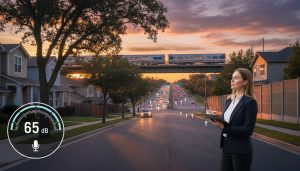Are there noise or traffic concerns?
Is this home ruined by traffic or noise? The one question buyers overlook—and the fast way to find out.
Quick answer
Noise and traffic concerns are assessable. You can measure them, spot red flags, and reduce risk. Homebuyers and real estate pros who check commute times, peak traffic, transit access, and local noise sources avoid costly surprises.
Why this matters now
Noise pollution and traffic congestion change quality of life and resale value. Properties near highways, train lines, airports, or busy intersections often sell faster at lower prices. Agents who quantify the problem win trust. Buyers who verify facts buy smarter.

Checklist: What to inspect on site
- Listen at different times: rush hour, late evening, early morning.
- Drive the commute at peak times.
- Check for nearby sources: highways, commuter rail, bus hubs, industrial sites, schools, bars.
- Look for physical buffers: berms, trees, sound walls, distance from road.
- Read zoning maps and future development plans.
Practical metrics to use
- Decibels (dB): 55–65 dB near roads affects daytime comfort; 45 dB at night is a useful threshold for sleep quality.
- Traffic counts and peak-hour congestion data: municipal or transportation department sources.
- Transit score and walkability index: quick proxy for traffic and accessibility.
- Commute time estimates from Google/Apple during rush hours.
Red flags that demand a hard pass
- Constant vehicle or train noise within 100–200 meters.
- Backup sirens all night from emergency routes.
- Plans for new highways, big-box stores, or transit terminals nearby.
- Frequent flooding that pushes traffic onto local streets.
If you see any, quantify how much it reduces livability and resale value.
Simple mitigation that preserves value
- Insulation upgrades: windows, doors, attic and wall insulation reduce 20–40% of noise impact.
- Landscaping: dense evergreen hedges and berms block sight and sound.
- Layout changes: position bedrooms away from the street, add vestibules.
- Sound barriers through community or municipal programs.

How noise and traffic affect price
Buyers pay for quiet and convenience. Noise lowers demand; congestion increases buyer churn. Use comparable sales adjusted for road proximity. Present clear evidence to justify price adjustments.
Action plan for buyers and agents
- Visit at 7am, noon, 5pm, 10pm.
- Record short video/audio clips for evidence.
- Pull traffic and noise data from official sources.
- List mitigation costs and include them in negotiations.
Final word
Don’t guess. Measure. Document. Use clear data to negotiate price or walk away. If you want an experienced local advisor who runs this checklist and negotiates for value, contact Tony Sousa.
Tony Sousa — Local Realtor
Email: tony@sousasells.ca | Phone: 416-477-2620 | https://www.sousasells.ca





















